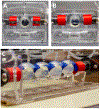Role of In Vitro Models for Development of Ophthalmic Delivery Systems
- PMID: 34348017
- PMCID: PMC8694856
- DOI: 10.1615/CritRevTherDrugCarrierSyst.2021035222
Role of In Vitro Models for Development of Ophthalmic Delivery Systems
Abstract
There is emergent need for in vitro models which are physiologically correct, easy to reproduce, and mimic characteristic functionalities of desired tissue, organ, or diseases state for ophthalmic drug screening, as well as disease modeling. To date, a variety of in vitro models have been developed for the applications ranging from 2D cell culture-based monolayers, multilayer, or co-culture models, to 3-dimensional (3D) organoids, 3D printed and organ on chip systems. Each model has its own pros and cons. While simple models are easier to create, and faster to reproduce, they lack recapitulation of the complex framework, functionalities, and properties of tissues or their subunits. Recent advancements in technologies and integration with tissue engineering and involvement of microfluidic systems have offered novel platforms which can better mimic the in vivo microenvironment, thus possessing potential in transformation of ophthalmic drug development. In this review we summarize existing in vitro ocular models while discussing applicability, drawbacks associated with them, and possible future applications.
Figures








References
-
- Wilson SL, Ahearne M, Hopkinson A. An overview of current techniques for ocular toxicity testing. Toxicology. 2015;327:32–46. - PubMed
-
- Huhtala A, Salminen L, Tähti H, Uusitalo H. Corneal models for the toxicity testing of drugs and drug releasing materials. In: Ashammakhi N, editor. Topics in multifunctional biomaterials and devices. 2008. p. 1–24.
Publication types
MeSH terms
Grants and funding
LinkOut - more resources
Full Text Sources
Miscellaneous

